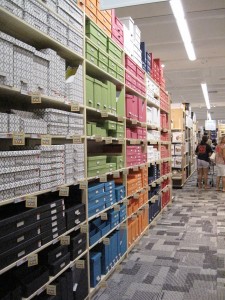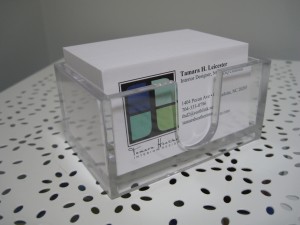 Charlotte, NC is now proud home to The Container Store. The national chain hosted the grand opening of its 50th store at South Park Mall last Saturday. And like an ant to a picnic, there I was early Saturday morning, one of many shoppers eager to check out the new store. With its gleaming aisles and tidily stacked shelves and colorful containers of every kind, the store does not disappoint.
Charlotte, NC is now proud home to The Container Store. The national chain hosted the grand opening of its 50th store at South Park Mall last Saturday. And like an ant to a picnic, there I was early Saturday morning, one of many shoppers eager to check out the new store. With its gleaming aisles and tidily stacked shelves and colorful containers of every kind, the store does not disappoint.
So, I will admit to having something of a weakness for containers – boxes, cubbies, vases, vessels, bowls, nooks, cupboards… things that hold other things. I get very excited. I have a kind of passion for organizing (obsession? maybe) and would trade a spa day for a day of closet organizing anytime.
It’s easy to visit a store like this and be lulled by the neatness and color-coordinated perfection into thinking this is the solution for all of the mess in your life. And then to start buying containers, lots of them, randomly (not that I’ve ever done that. Yes, I have.) Whether you live in a tiny bungalow, an efficient urban condo or a spacious home in the suburbs, effective storage and organization is an issue most people grapple with. But before you go to the home goods store of your choice, I recommend having a plan, and to consider a few things before you shop:
1. Purge the excess
As the old rule goes, if you haven’t used/worn it in a year, sell, donate or dispose of it. Once you give up the things that are no longer adding value to your life, you may find there’s plenty of space to accommodate the things that are.
2. Identify your storage needs
Now, look around your home – what things seem to be consistently left lying out? (If there’s a layer of dust, that’s a clue.) Maybe it’s newspapers, or shoes, or the electric hand mixer that goes on the high shelf you can’t reach. Those are the things that need a storage solution. Make a list.
3. Devise a storage solution
Figure out where these things will live. Make it as convenient as possible to put them where they belong, with consideration to how you move around your home. For example, if you take off shoes at the front door, you need some shoe storage near the front door. If possible, plan for storage that is visible. If you can’t see something, you will probably forget you own it. Keep in mind that almost any airspace can be tapped for storage, from the area under the stairs to the vertical space between items on shelves.
4. Quantify your storage needs
Count and measure the items needing storage. Have this information with you when you go shopping.
5. Consider alternative sources (and alternative uses) for storage containers
Thrift stores, flea markets, antique malls, garage sales and local hardware stores are all viable sources. Shelter magazines and blogs (such as Real Simple, Martha Stewart Living, Apartment Therapy) offer some great ideas on using alternative storage containers. They’re always showing things like a Hungarian baby bathtub repurposed as a planter. Not that you’d necessarily go out shopping for a Hungarian baby bathtub. But the idea is, look for interesting storage devices and use them interestingly.
And when you’ve done all this, then, you may want to pay a visit to the Container Store. Because they do have some really nice, and specific kinds of storage devices you can’t find almost anywhere else. Like an acrylic holder for showing off your new business cards:




